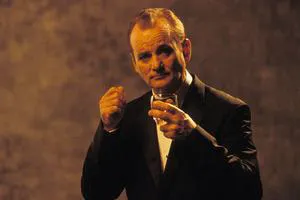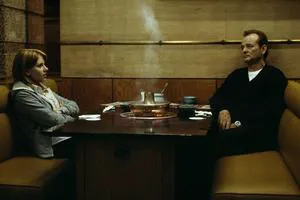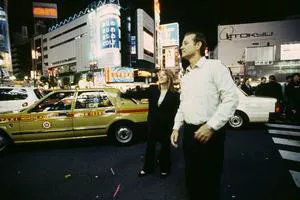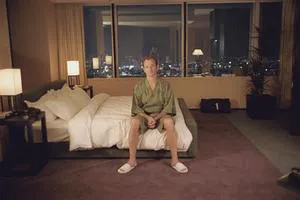After Sofia Coppola’s acting debut in “The Godfather Part III” was met with harsh criticism, the daughter of the staunch family and tradition advocate never set foot in the “American Zoetrope” film studio as an actress again. She turned to photography and writing, and ten years later, she directed “The Virgin Suicides” – a film so meticulously pristine that, much like in 1990, Sofia was quickly accused of lacking artistic audacity. This time, Coppola chose not to react to the hurtful remarks, demonstrating courage and remaining true to her chosen style.
A Distinct Voice Emerges
“Lost in Translation” turned out to be as smooth and airy as her previous film, and even more detached. Coppola, the screenwriter and director of “Lost in Translation,” abandoned the voice-over narration and pseudo-reportage commentary that had been used in “The Virgin Suicides” to defend certain plot twists and psychological experiences. Now, she very successfully tells the story of Americans in Japan solely through cinematic means, with minimal reliance on verbal description. The years spent mastering the concise expressiveness of photography had clearly paid off.

The calm tone remained the same, with which, contrary to the notion of hysteria as an inherent trait of a certain gender, Coppola makes films about deeply hidden feelings, subtle yet far from serene processes – such as the torment of youthful extremism fading away, or, in her new film, the bliss of fleeting harmony between people.
The term “elegy” – meditative lyricism – best describes Coppola’s films. Sadness and drama without ostentation, a light, ironic detachment. This is usually embedded in the significance of the title itself. Even before seeing “Lost in Translation,” one suspects that it is most likely about the difficulty people from different cultures have in finding a common language. Indeed, seasoned Hollywood actor Bob Harris (Bill Murray) comes to Tokyo to do some work in a local whiskey commercial and, without speaking a word of Japanese, comically finds himself in awkward situations on set, in bars, and when interacting with reporters, waiters, and prostitutes. Young American Charlotte (Scarlett Johansson) faces similar problems, forced to spend her days wandering aimlessly around the city while her husband is at work. The easily discernible meaning declared in the opening scenes honestly serves as a refrain. But “Lost in Translation” also signifies the inevitable losses when attempting to combine any dissimilar things, actors, and phenomena.
Unlikely Connections

It is hard to imagine more dissimilar people than Bob and Charlotte, flesh and blood of the 60s and 80s generations. A man and a woman, she in her early twenties, he in his fifties. His marriage has lasted over two decades, with a bunch of children. She has been married for two years and, judging by her slightly fuller waistline, is not long carrying her first child. Bob is an active professional, an actor accustomed to publicly displaying emotions, while Charlotte is a housewife and unemployed philosopher, used to suppressing emotions, analyzing them, and doubting the legitimacy of their appearance. His future is thoroughly steeped in the past, while she feels that life has not yet begun.

Despite such a significant difference in potential – “not yet” and “already” – the characters find themselves in identical situations and experience similar reflexes towards the world. Both are homesick in a foreign country, regretting that they are forced to kill time. Hieroglyphs are in no hurry to part with their guarded meaning, and local philosophy and culture do not offer friendly embraces. A series of short episodes about how the characters spend their days and nights – insomnia, drinking, unsuccessful attempts to have fun with people of different interests, lethargic sports activities, walks among the sights – make it clear that depression is not far off. Classic orphaned loneliness in the throes of a transitional age. From the hopes of uncompromising youth to the longing of conscious maturity. From the belief that the best is yet to come, to the realization that you cannot run away from yourself and change nothing. Different in form and content, Bob and Charlotte have a kindred emotional disposition and, once meeting at a bar, begin to talk as if they are good friends who know each other’s innermost secrets and do not need explanations. Having nothing in common in the past, they will not intersect in the future, but today gives them paradise for two. The intimate connection is far from intimate. It’s as if the director is filming a mirror image of “9 1/2 Weeks” and replacing the frenzy of sexuality with antediluvian innocence. Charlotte and Bob are inseparable and spend days and nights in companies and restaurants, dine and have breakfast together, and even sleep in the same bed. In their relationship, as if before the fall, there is no hint of complicating eroticism, and they only kiss once, before parting. For a short period, a man and a woman can speak the same language.
The Ephemeral Nature of Connection

The time when the possibility of finding identity is born is the main character of the film. It loses its absolute character and turns into a relative value. Such relationships between characters are possible only in the present moment, in a specific city and conditioned space, despite (thanks to) all permissible difficulties of translation.
Not satisfied with a wide angle of observation, Sofia Coppola gives her picture a fourth coordinate.